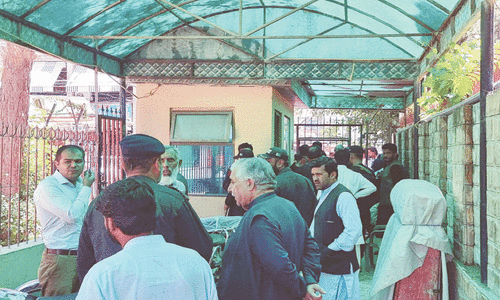LAHORE, March 27: Punjab Planning and Development Board chairperson Salman Ghani said here on Tuesday the provincial government was considering enactment of a law for the walled city development project within six months.
The Punjab government had already identified a pilot project as part of the development of the walled city and its circular gardens to preserve the rich cultural asset.
“The final draft of the bill has been worked out and will be presented before the Punjab Assembly for legislation which is the most fundamental task,” Mr Ghani said at a seminar on Tuesday.
Besides, work on the documentation of all monuments and historical buildings had also begun. He said the government would also ensure that the historical buildings were no longer exposed to any form of pollution.
The 1.7-kilometre long linear royal trail (Shahi Guzargah) which the Mughal emperors coming from Delhi used to reach the Lahore Fort and the Badshahi Masjid has been selected as the pilot project. It envisages the regeneration and renovation of the Delhi Gate, the Shahi Hammam (royal bath), Masjid Wazir Khan, Sunehri Masjid, Baoli Bagh (a small park), Maryam Zamani Masjid and the Akbari Gate to the Lahore Fort for which a developmental policy framework has already been prepared.
The PP&DB has also established a project management unit for the pilot project which envisages an urban heritage trail en route for the development of tourism facilities like signage, food and beverages, services of guides and setting up markets of local arts and handicraft.
The comprehensive Punjab government-sponsored project is funded by the World Bank which has provided $10 million for it. Besides, the Aga Khan Foundation has made a financial commitment for the restoration of the circular gardens.
Speaking at the inaugural session, Punjab Chief Secretary Salman Siddique announced that the provincial government would implement the project with a commitment to history and the city’s cultural heritage. A developmental policy framework was being worked out and the government had also started the process of enacting a law to give legal validity to the project.
According to him, the government was preserving the cultural heritage of more cities, including Multan, Faisalabad and Sialkot. The Lahore-Sialkot Expressway was part of the project which also meant the development of major cities as engines of growth.
The director-general of the project, Humayun Farshori, said major obstacles in the way of the project were encroachments, occupation of state land by influential groups and even some government departments, besides dense population. Overhead electricity and telephone wires also added to the problem.
He said the circular gardens covered an area of 106 acres of which 31 acres were in the occupation of power and water supply departments which had set up grid stations and tubewells. At least 63 power transformers were also a major obstacle to the task.
All wires would go underground, water supply lines would be properly covered and encroachments removed to carry out the project, he said.
Three papers were presented in the working session. Fakir Syed Aijazuddin narrated the ‘journey through time’ with the help of photographs, graphics, sketches and paintings and some of them dated back to the 1930s. He dilated upon monuments and other historical buildings inside the walled city and other parts of Lahore built during the Mughal, Sikh and British period. He pleaded for a complete documentation of what was left of the city’s rich cultural part.
Dr Shaukat Mahmood, who contributes cartoons to newspapers by the pen name of Maxim, came strongly on successive governments which, he said, had vandalised centuries-old monumental buildings by sponsoring state functions. The governments, he said, attached no priority to the monuments which were now in an advanced stage of decay.
He particularly mentioned the 1,200-foot long and 52-foot high picture wall in the Lahore Fort, saying the one and only such mural in the world was fading because of air, noise and smoke pollution. Similarly, the Shish Mahal, the only mirrored ceiling, was also exposed to a similar threat.
The project’s Italian consultant, Raffaele Gorjux, who has the experience of restoring Faiz of Medina in Morocco, a city which has many similarities with Lahore, contended that the absence of an institutional and legal framework in addition to lack of facilities, pollution and encroachments were major impediments to the assignment.
He said the old Lahore had a great economic potential and growth of employment opportunities provided the facilities required to attract tourists and investment were made available.









































Dear visitor, the comments section is undergoing an overhaul and will return soon.